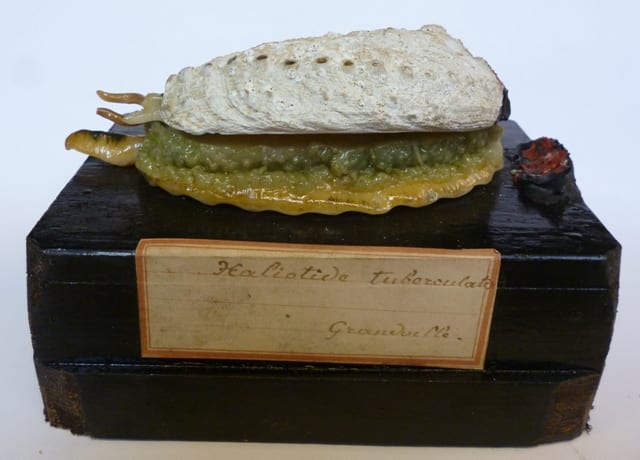Specimen of the Week: Week 136
By Mark Carnall, on 19 May 2014
 Did you know that of the 135 previous specimen of the week posts only 20% of them have featured invertebrates! I’m abusing my specimen of the week writing privileges to do my best to address this grave misrepresentation. Poor invertebrates. This week I’ve chosen a specimen that is part biological material, part model that gives us an insight into how biology was taught in the past.
Did you know that of the 135 previous specimen of the week posts only 20% of them have featured invertebrates! I’m abusing my specimen of the week writing privileges to do my best to address this grave misrepresentation. Poor invertebrates. This week I’ve chosen a specimen that is part biological material, part model that gives us an insight into how biology was taught in the past.
This week’s specimen of the week is…
**Wax model of the green ormer**
1) What do you mean you’ve never heard of a green ormer? The green ormer, also known as the European edible abalone or tuberculate ormer, is a gastropod mollusc. The more familiar gastropod molluscs are snails with their characteristic spiral shells but amongst the gastropods there is a huge diversity of shell shapes including bubble shells, slipper snails, keyhole limpets and abalones or ear shells like our specimen here. Abalones or ormers have low open spiralled shells with a characteristic row of pores along the edge of the shell.
2) The specimen we have here is a real shell attached to a wax model made by the Maison Tramond, a Parisian preparator studio which produced exquisite composite models showing soft tissue anatomy. Opening in 1878 the studio created hundreds of models many of which were bought by museums to use in display and teaching. Recently, a very excited visitor spotted some of our Tramond specimens on display including this one, a previously unknown model. The Tramond studio did publish catalogues of specimens to be purchased but currently we think that this model and several other mollusc models we have were special orders and are of slightly higher ceroplastic quality. These models are very fragile, especially the colours used in the wax and we are lucky to have our models in such good condition given they would have been on display for a long time. The shell was originally mounted next to the model so that all of the internal anatomy could be seen.
3) Abalone shells were highly sought after and every shell collector would have an abalone shell or two in their collection due to the highly iridescent nacre layer of the shell. This nacre is used extensively in jewellery, as inlay in furniture and as a decoration in fashion. Abalones do produce pearls which aren’t round like pearl oysters but they do come in a wonderful array of colours. Occasionally, abalone shells are found with two rows of pores and these are prized by collectors.
4) The green ormer is a European species that can be found grazing on algae in rocky shore environments. The scientific name for green ormer is Haliotis tuberculata. All abalone shells are in the genus Haliotis, but the classification of Haliotis is far from being resolved. There are anywhere between 30 and 230 described species, the high variability within any given species causing problems. Due to their popularity with shell collectors as well as being eaten in many places the abalones have a wonderful array of common names, some of my favourites are; ass’s ear abalone, the splendid abalone and the, presumably even better, most beautiful abalone.
5) Many abalone species are edible and are considered a delicacy. Food demand as well as the demand for the shells for collections, jewellery and fashion means that many wild abalone species are overfished. Taking abalones from the wild is illegal or tightly controlled in many countries. Control measures are often to restrict the method that can be used to take abalones, restrict the time that abalones can be fished and/or to restrict the size of abalones that can be taken. In Japan and China abalones have been farmed since the 1950s and 1960s. The world’s first recorded underwater arrest was a man who was illegally ‘ormering’ in Guernsey in 1969 where the collecting of abalones has been tightly controlled for a long time.
Mark Carnall is the Curator of the Grant Museum of Zoology
One Response to “Specimen of the Week: Week 136”
- 1
 Close
Close





[…] way to think about it. With that in mind I knew I was keen to advance the agenda set out by Mark to address the big and furry vertebrate imbalance (nb. not all vertebrates are either big or furry) […]